Managerial Accounting: Cost-Volume-Profit Analysis and Budgeting Cases
VerifiedAdded on 2023/06/15
|16
|2947
|398
Case Study
AI Summary
This document presents solutions to several case studies in managerial accounting, covering topics such as cost analysis, profit maximization, and budgeting. The first case examines the profitability of a catering company's standard cocktail party and explores bidding strategies for a charity event. The second case analyzes sales commission structures and evaluates the financial implications of employing a dedicated sales force versus using independent agents, including breakeven point calculations and operating income projections. The final case focuses on the impact of new machinery on overhead rates and job costing, assessing the cost implications and managerial concerns associated with the changes. The analysis and solutions are presented with detailed calculations and justifications.
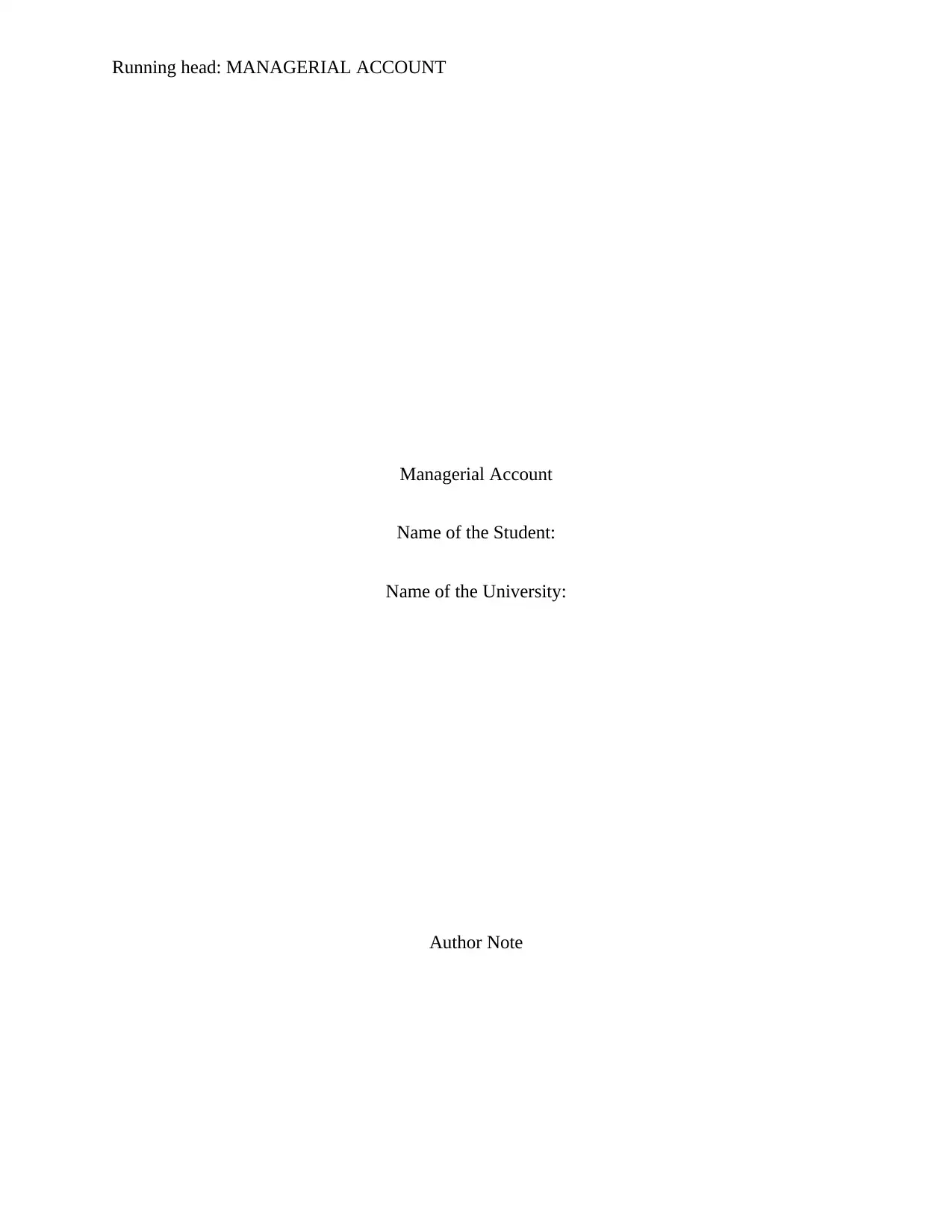
Running head: MANAGERIAL ACCOUNT
Managerial Account
Name of the Student:
Name of the University:
Author Note
Managerial Account
Name of the Student:
Name of the University:
Author Note
Paraphrase This Document
Need a fresh take? Get an instant paraphrase of this document with our AI Paraphraser
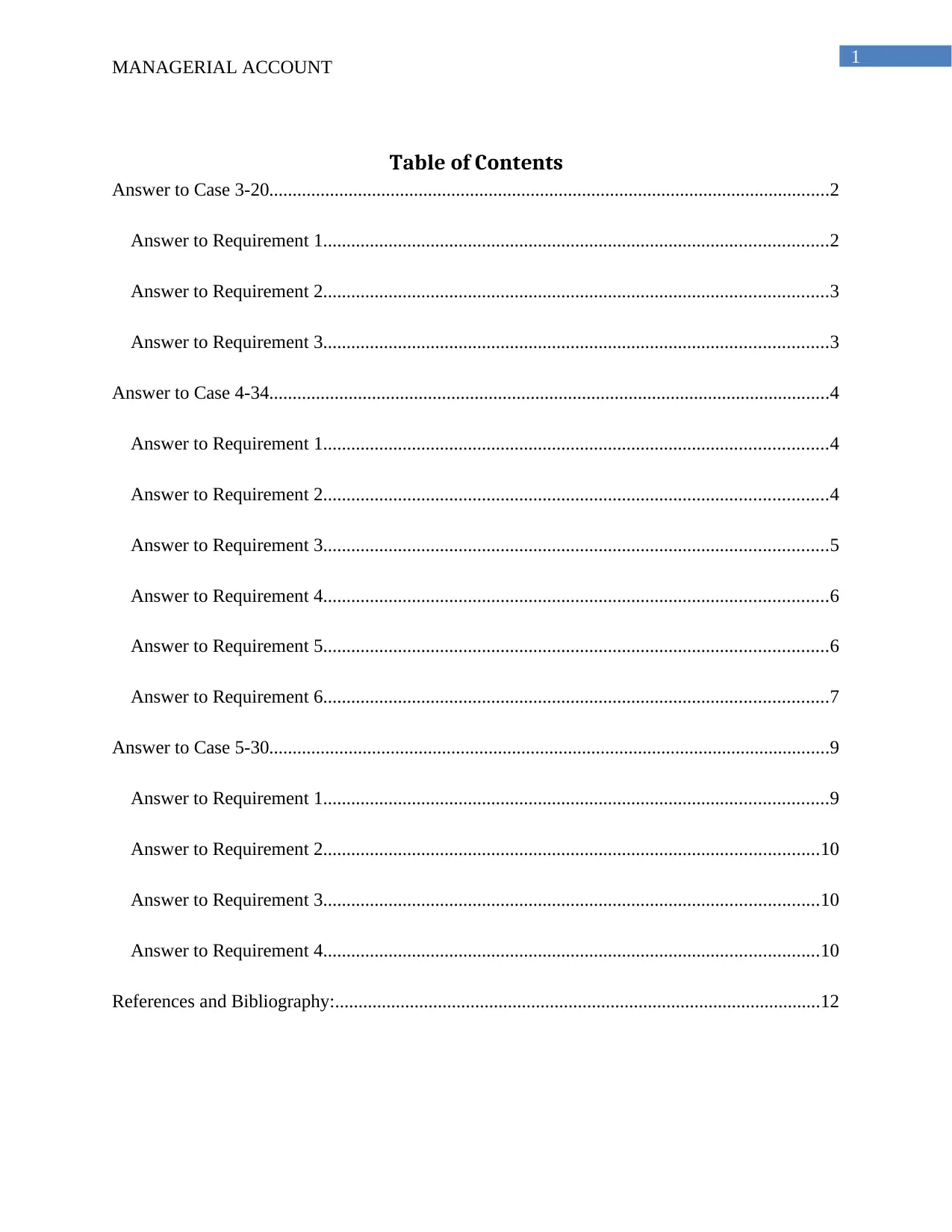
1
MANAGERIAL ACCOUNT
Table of Contents
Answer to Case 3-20........................................................................................................................2
Answer to Requirement 1............................................................................................................2
Answer to Requirement 2............................................................................................................3
Answer to Requirement 3............................................................................................................3
Answer to Case 4-34........................................................................................................................4
Answer to Requirement 1............................................................................................................4
Answer to Requirement 2............................................................................................................4
Answer to Requirement 3............................................................................................................5
Answer to Requirement 4............................................................................................................6
Answer to Requirement 5............................................................................................................6
Answer to Requirement 6............................................................................................................7
Answer to Case 5-30........................................................................................................................9
Answer to Requirement 1............................................................................................................9
Answer to Requirement 2..........................................................................................................10
Answer to Requirement 3..........................................................................................................10
Answer to Requirement 4..........................................................................................................10
References and Bibliography:........................................................................................................12
MANAGERIAL ACCOUNT
Table of Contents
Answer to Case 3-20........................................................................................................................2
Answer to Requirement 1............................................................................................................2
Answer to Requirement 2............................................................................................................3
Answer to Requirement 3............................................................................................................3
Answer to Case 4-34........................................................................................................................4
Answer to Requirement 1............................................................................................................4
Answer to Requirement 2............................................................................................................4
Answer to Requirement 3............................................................................................................5
Answer to Requirement 4............................................................................................................6
Answer to Requirement 5............................................................................................................6
Answer to Requirement 6............................................................................................................7
Answer to Case 5-30........................................................................................................................9
Answer to Requirement 1............................................................................................................9
Answer to Requirement 2..........................................................................................................10
Answer to Requirement 3..........................................................................................................10
Answer to Requirement 4..........................................................................................................10
References and Bibliography:........................................................................................................12

2
MANAGERIAL ACCOUNT
MANAGERIAL ACCOUNT
⊘ This is a preview!⊘
Do you want full access?
Subscribe today to unlock all pages.

Trusted by 1+ million students worldwide
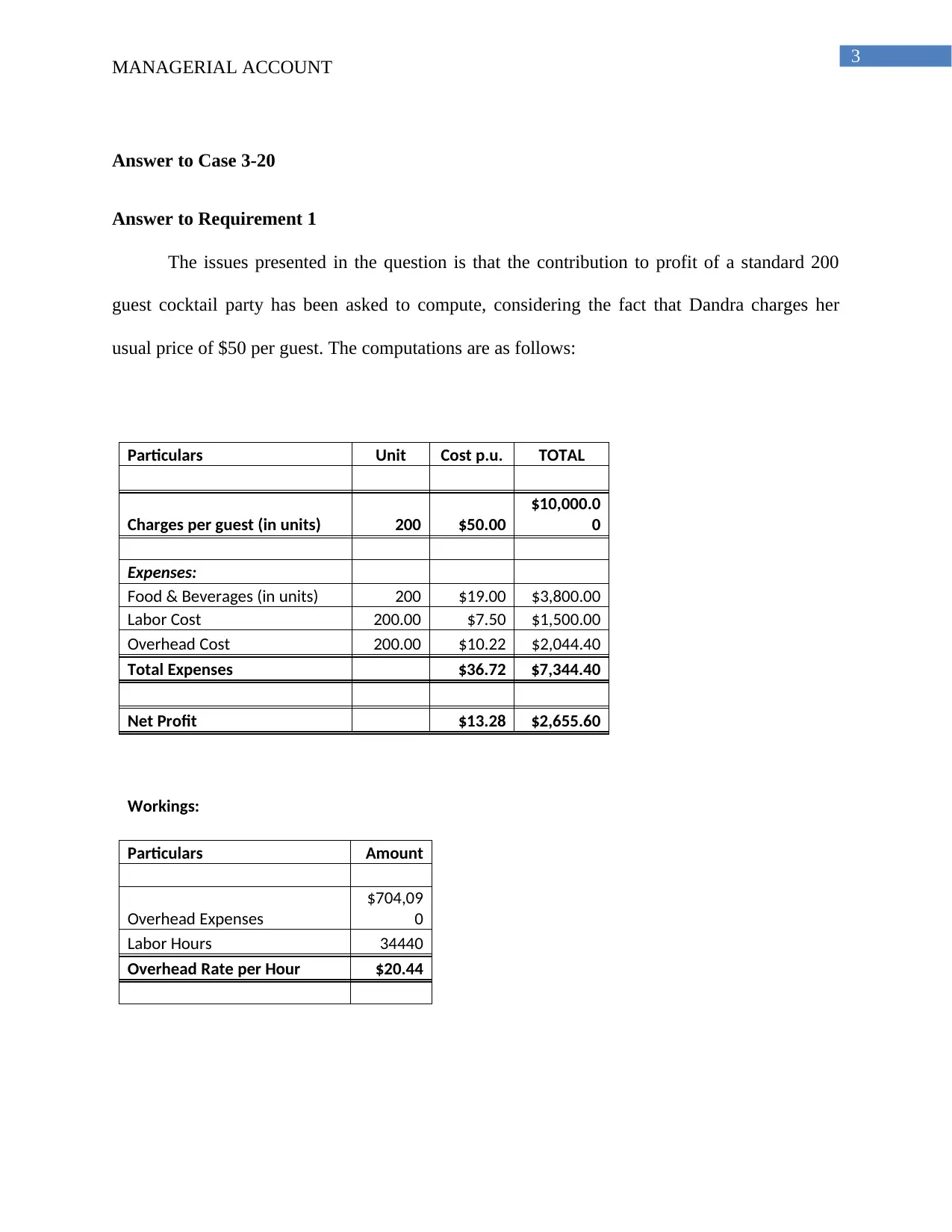
3
MANAGERIAL ACCOUNT
Answer to Case 3-20
Answer to Requirement 1
The issues presented in the question is that the contribution to profit of a standard 200
guest cocktail party has been asked to compute, considering the fact that Dandra charges her
usual price of $50 per guest. The computations are as follows:
Particulars Unit Cost p.u. TOTAL
Charges per guest (in units) 200 $50.00
$10,000.0
0
Expenses:
Food & Beverages (in units) 200 $19.00 $3,800.00
Labor Cost 200.00 $7.50 $1,500.00
Overhead Cost 200.00 $10.22 $2,044.40
Total Expenses $36.72 $7,344.40
Net Profit $13.28 $2,655.60
Workings:
Particulars Amount
Overhead Expenses
$704,09
0
Labor Hours 34440
Overhead Rate per Hour $20.44
MANAGERIAL ACCOUNT
Answer to Case 3-20
Answer to Requirement 1
The issues presented in the question is that the contribution to profit of a standard 200
guest cocktail party has been asked to compute, considering the fact that Dandra charges her
usual price of $50 per guest. The computations are as follows:
Particulars Unit Cost p.u. TOTAL
Charges per guest (in units) 200 $50.00
$10,000.0
0
Expenses:
Food & Beverages (in units) 200 $19.00 $3,800.00
Labor Cost 200.00 $7.50 $1,500.00
Overhead Cost 200.00 $10.22 $2,044.40
Total Expenses $36.72 $7,344.40
Net Profit $13.28 $2,655.60
Workings:
Particulars Amount
Overhead Expenses
$704,09
0
Labor Hours 34440
Overhead Rate per Hour $20.44
Paraphrase This Document
Need a fresh take? Get an instant paraphrase of this document with our AI Paraphraser
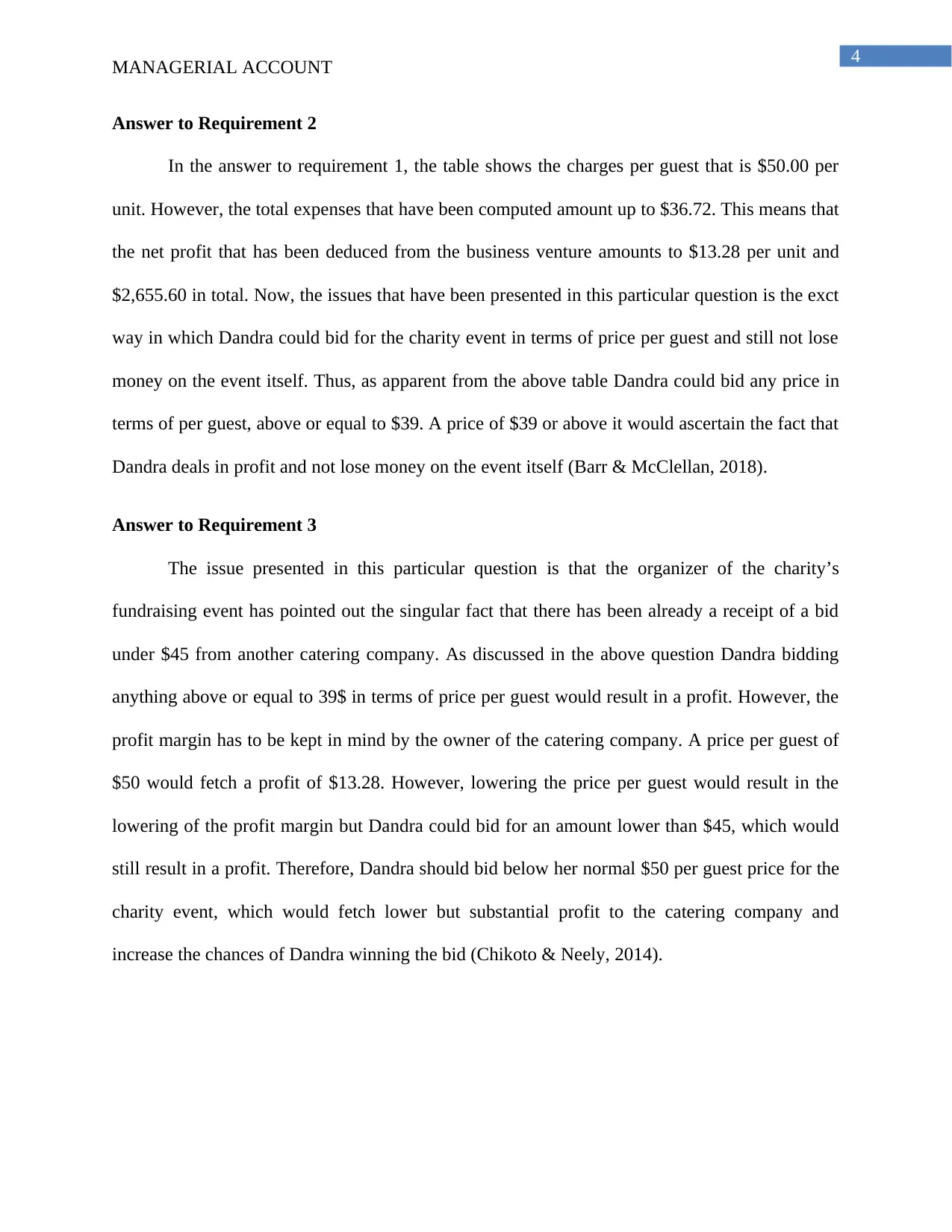
4
MANAGERIAL ACCOUNT
Answer to Requirement 2
In the answer to requirement 1, the table shows the charges per guest that is $50.00 per
unit. However, the total expenses that have been computed amount up to $36.72. This means that
the net profit that has been deduced from the business venture amounts to $13.28 per unit and
$2,655.60 in total. Now, the issues that have been presented in this particular question is the exct
way in which Dandra could bid for the charity event in terms of price per guest and still not lose
money on the event itself. Thus, as apparent from the above table Dandra could bid any price in
terms of per guest, above or equal to $39. A price of $39 or above it would ascertain the fact that
Dandra deals in profit and not lose money on the event itself (Barr & McClellan, 2018).
Answer to Requirement 3
The issue presented in this particular question is that the organizer of the charity’s
fundraising event has pointed out the singular fact that there has been already a receipt of a bid
under $45 from another catering company. As discussed in the above question Dandra bidding
anything above or equal to 39$ in terms of price per guest would result in a profit. However, the
profit margin has to be kept in mind by the owner of the catering company. A price per guest of
$50 would fetch a profit of $13.28. However, lowering the price per guest would result in the
lowering of the profit margin but Dandra could bid for an amount lower than $45, which would
still result in a profit. Therefore, Dandra should bid below her normal $50 per guest price for the
charity event, which would fetch lower but substantial profit to the catering company and
increase the chances of Dandra winning the bid (Chikoto & Neely, 2014).
MANAGERIAL ACCOUNT
Answer to Requirement 2
In the answer to requirement 1, the table shows the charges per guest that is $50.00 per
unit. However, the total expenses that have been computed amount up to $36.72. This means that
the net profit that has been deduced from the business venture amounts to $13.28 per unit and
$2,655.60 in total. Now, the issues that have been presented in this particular question is the exct
way in which Dandra could bid for the charity event in terms of price per guest and still not lose
money on the event itself. Thus, as apparent from the above table Dandra could bid any price in
terms of per guest, above or equal to $39. A price of $39 or above it would ascertain the fact that
Dandra deals in profit and not lose money on the event itself (Barr & McClellan, 2018).
Answer to Requirement 3
The issue presented in this particular question is that the organizer of the charity’s
fundraising event has pointed out the singular fact that there has been already a receipt of a bid
under $45 from another catering company. As discussed in the above question Dandra bidding
anything above or equal to 39$ in terms of price per guest would result in a profit. However, the
profit margin has to be kept in mind by the owner of the catering company. A price per guest of
$50 would fetch a profit of $13.28. However, lowering the price per guest would result in the
lowering of the profit margin but Dandra could bid for an amount lower than $45, which would
still result in a profit. Therefore, Dandra should bid below her normal $50 per guest price for the
charity event, which would fetch lower but substantial profit to the catering company and
increase the chances of Dandra winning the bid (Chikoto & Neely, 2014).
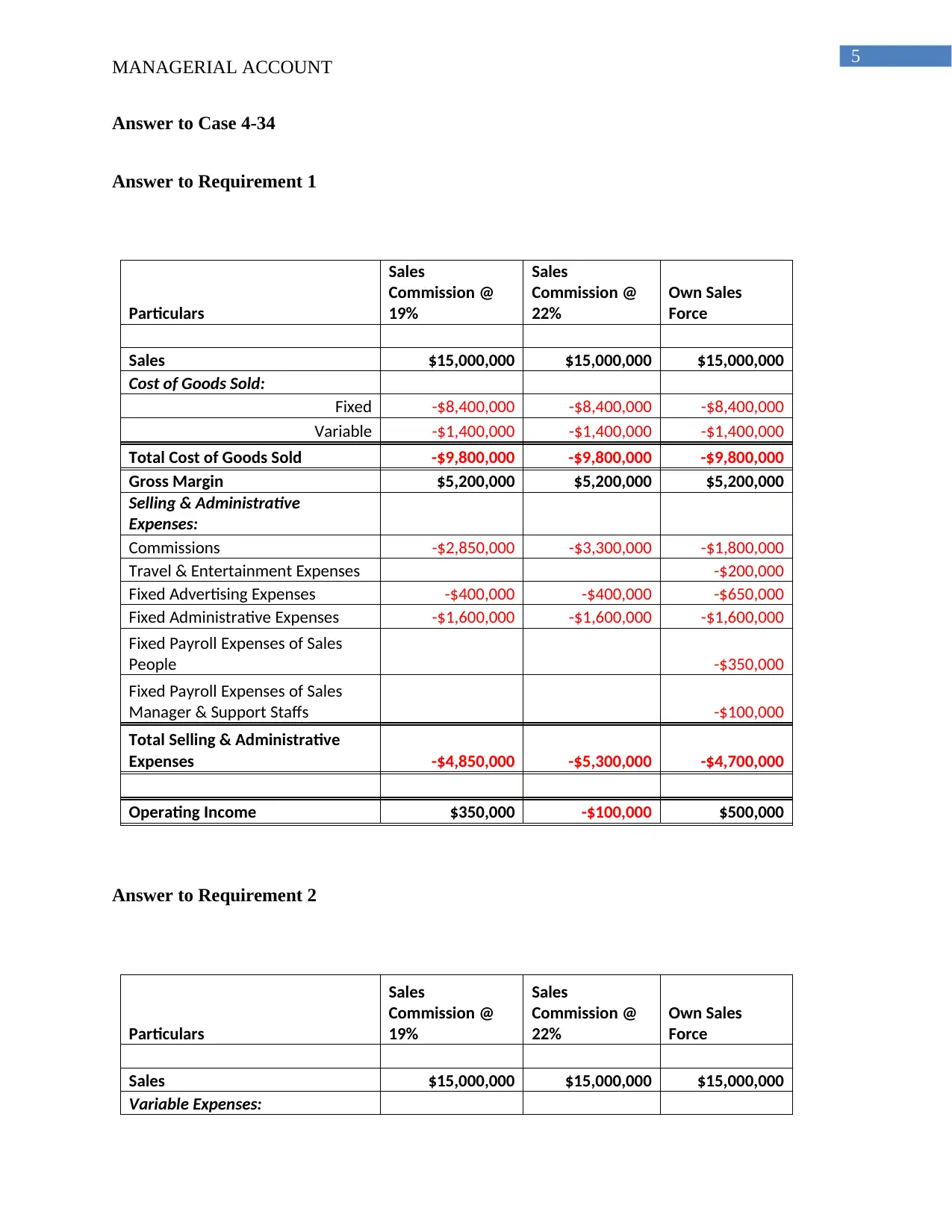
5
MANAGERIAL ACCOUNT
Answer to Case 4-34
Answer to Requirement 1
Particulars
Sales
Commission @
19%
Sales
Commission @
22%
Own Sales
Force
Sales $15,000,000 $15,000,000 $15,000,000
Cost of Goods Sold:
Fixed -$8,400,000 -$8,400,000 -$8,400,000
Variable -$1,400,000 -$1,400,000 -$1,400,000
Total Cost of Goods Sold -$9,800,000 -$9,800,000 -$9,800,000
Gross Margin $5,200,000 $5,200,000 $5,200,000
Selling & Administrative
Expenses:
Commissions -$2,850,000 -$3,300,000 -$1,800,000
Travel & Entertainment Expenses -$200,000
Fixed Advertising Expenses -$400,000 -$400,000 -$650,000
Fixed Administrative Expenses -$1,600,000 -$1,600,000 -$1,600,000
Fixed Payroll Expenses of Sales
People -$350,000
Fixed Payroll Expenses of Sales
Manager & Support Staffs -$100,000
Total Selling & Administrative
Expenses -$4,850,000 -$5,300,000 -$4,700,000
Operating Income $350,000 -$100,000 $500,000
Answer to Requirement 2
Particulars
Sales
Commission @
19%
Sales
Commission @
22%
Own Sales
Force
Sales $15,000,000 $15,000,000 $15,000,000
Variable Expenses:
MANAGERIAL ACCOUNT
Answer to Case 4-34
Answer to Requirement 1
Particulars
Sales
Commission @
19%
Sales
Commission @
22%
Own Sales
Force
Sales $15,000,000 $15,000,000 $15,000,000
Cost of Goods Sold:
Fixed -$8,400,000 -$8,400,000 -$8,400,000
Variable -$1,400,000 -$1,400,000 -$1,400,000
Total Cost of Goods Sold -$9,800,000 -$9,800,000 -$9,800,000
Gross Margin $5,200,000 $5,200,000 $5,200,000
Selling & Administrative
Expenses:
Commissions -$2,850,000 -$3,300,000 -$1,800,000
Travel & Entertainment Expenses -$200,000
Fixed Advertising Expenses -$400,000 -$400,000 -$650,000
Fixed Administrative Expenses -$1,600,000 -$1,600,000 -$1,600,000
Fixed Payroll Expenses of Sales
People -$350,000
Fixed Payroll Expenses of Sales
Manager & Support Staffs -$100,000
Total Selling & Administrative
Expenses -$4,850,000 -$5,300,000 -$4,700,000
Operating Income $350,000 -$100,000 $500,000
Answer to Requirement 2
Particulars
Sales
Commission @
19%
Sales
Commission @
22%
Own Sales
Force
Sales $15,000,000 $15,000,000 $15,000,000
Variable Expenses:
⊘ This is a preview!⊘
Do you want full access?
Subscribe today to unlock all pages.

Trusted by 1+ million students worldwide
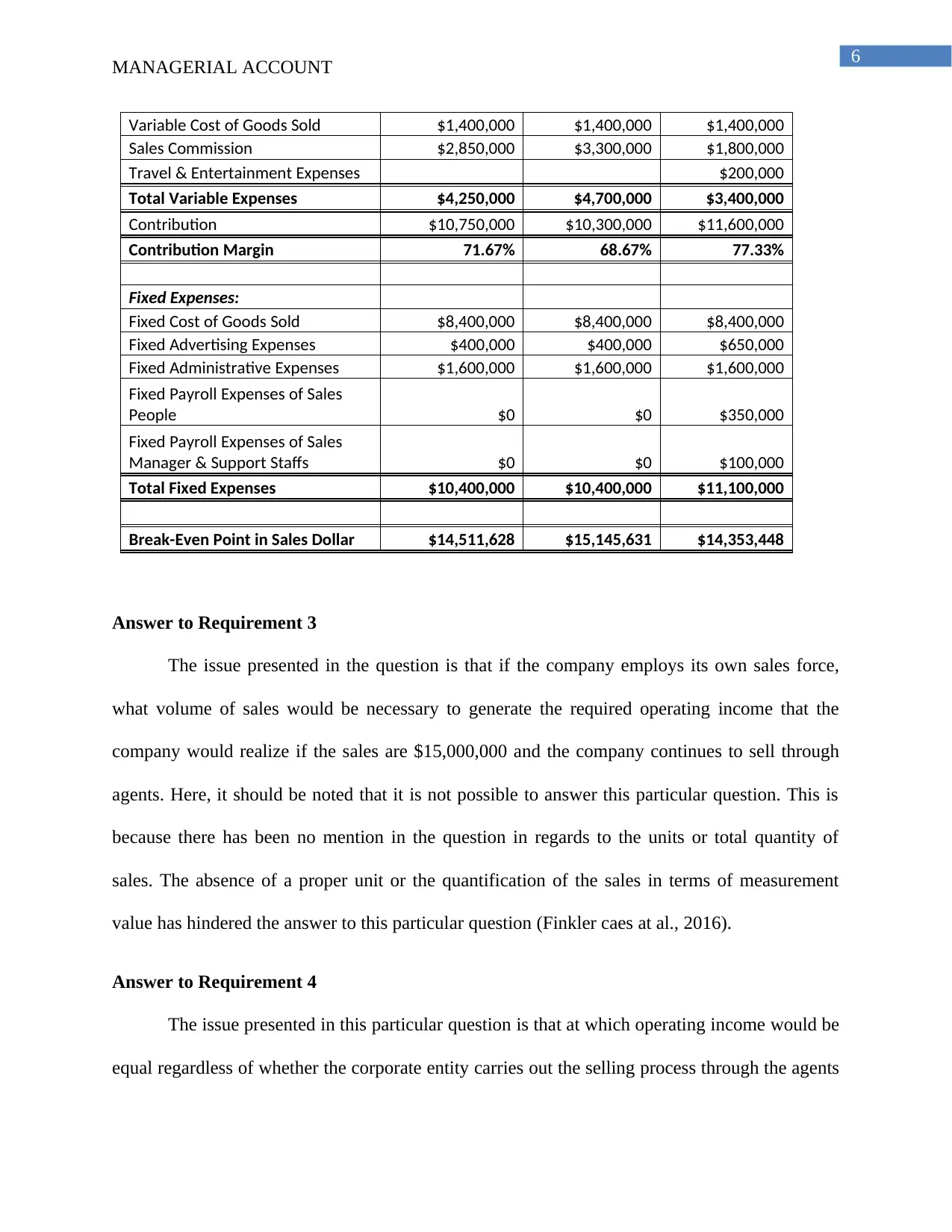
6
MANAGERIAL ACCOUNT
Variable Cost of Goods Sold $1,400,000 $1,400,000 $1,400,000
Sales Commission $2,850,000 $3,300,000 $1,800,000
Travel & Entertainment Expenses $200,000
Total Variable Expenses $4,250,000 $4,700,000 $3,400,000
Contribution $10,750,000 $10,300,000 $11,600,000
Contribution Margin 71.67% 68.67% 77.33%
Fixed Expenses:
Fixed Cost of Goods Sold $8,400,000 $8,400,000 $8,400,000
Fixed Advertising Expenses $400,000 $400,000 $650,000
Fixed Administrative Expenses $1,600,000 $1,600,000 $1,600,000
Fixed Payroll Expenses of Sales
People $0 $0 $350,000
Fixed Payroll Expenses of Sales
Manager & Support Staffs $0 $0 $100,000
Total Fixed Expenses $10,400,000 $10,400,000 $11,100,000
Break-Even Point in Sales Dollar $14,511,628 $15,145,631 $14,353,448
Answer to Requirement 3
The issue presented in the question is that if the company employs its own sales force,
what volume of sales would be necessary to generate the required operating income that the
company would realize if the sales are $15,000,000 and the company continues to sell through
agents. Here, it should be noted that it is not possible to answer this particular question. This is
because there has been no mention in the question in regards to the units or total quantity of
sales. The absence of a proper unit or the quantification of the sales in terms of measurement
value has hindered the answer to this particular question (Finkler caes at al., 2016).
Answer to Requirement 4
The issue presented in this particular question is that at which operating income would be
equal regardless of whether the corporate entity carries out the selling process through the agents
MANAGERIAL ACCOUNT
Variable Cost of Goods Sold $1,400,000 $1,400,000 $1,400,000
Sales Commission $2,850,000 $3,300,000 $1,800,000
Travel & Entertainment Expenses $200,000
Total Variable Expenses $4,250,000 $4,700,000 $3,400,000
Contribution $10,750,000 $10,300,000 $11,600,000
Contribution Margin 71.67% 68.67% 77.33%
Fixed Expenses:
Fixed Cost of Goods Sold $8,400,000 $8,400,000 $8,400,000
Fixed Advertising Expenses $400,000 $400,000 $650,000
Fixed Administrative Expenses $1,600,000 $1,600,000 $1,600,000
Fixed Payroll Expenses of Sales
People $0 $0 $350,000
Fixed Payroll Expenses of Sales
Manager & Support Staffs $0 $0 $100,000
Total Fixed Expenses $10,400,000 $10,400,000 $11,100,000
Break-Even Point in Sales Dollar $14,511,628 $15,145,631 $14,353,448
Answer to Requirement 3
The issue presented in the question is that if the company employs its own sales force,
what volume of sales would be necessary to generate the required operating income that the
company would realize if the sales are $15,000,000 and the company continues to sell through
agents. Here, it should be noted that it is not possible to answer this particular question. This is
because there has been no mention in the question in regards to the units or total quantity of
sales. The absence of a proper unit or the quantification of the sales in terms of measurement
value has hindered the answer to this particular question (Finkler caes at al., 2016).
Answer to Requirement 4
The issue presented in this particular question is that at which operating income would be
equal regardless of whether the corporate entity carries out the selling process through the agents
Paraphrase This Document
Need a fresh take? Get an instant paraphrase of this document with our AI Paraphraser
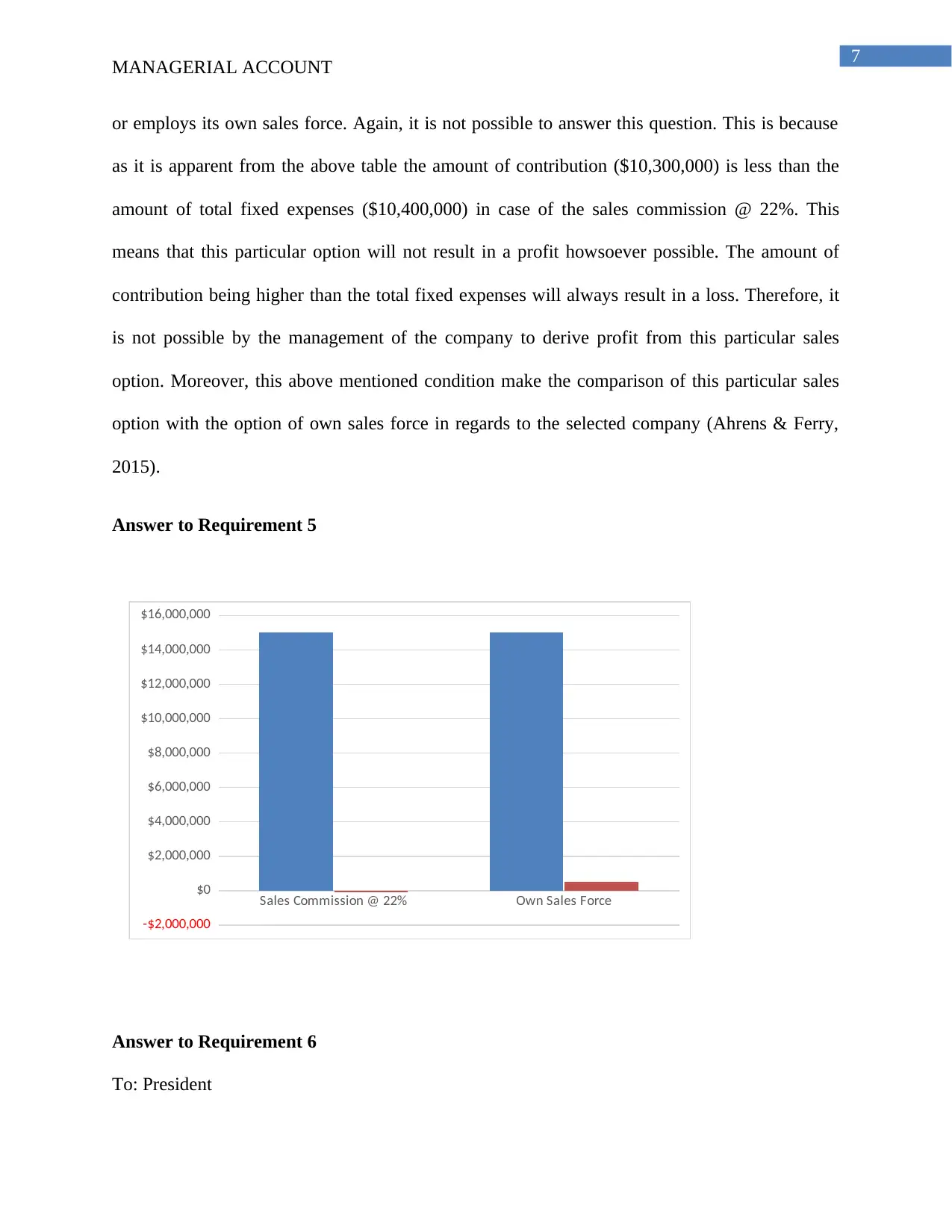
7
MANAGERIAL ACCOUNT
or employs its own sales force. Again, it is not possible to answer this question. This is because
as it is apparent from the above table the amount of contribution ($10,300,000) is less than the
amount of total fixed expenses ($10,400,000) in case of the sales commission @ 22%. This
means that this particular option will not result in a profit howsoever possible. The amount of
contribution being higher than the total fixed expenses will always result in a loss. Therefore, it
is not possible by the management of the company to derive profit from this particular sales
option. Moreover, this above mentioned condition make the comparison of this particular sales
option with the option of own sales force in regards to the selected company (Ahrens & Ferry,
2015).
Answer to Requirement 5
Answer to Requirement 6
To: President
Sales Commission @ 22% Own Sales Force
-$2,000,000
$0
$2,000,000
$4,000,000
$6,000,000
$8,000,000
$10,000,000
$12,000,000
$14,000,000
$16,000,000
MANAGERIAL ACCOUNT
or employs its own sales force. Again, it is not possible to answer this question. This is because
as it is apparent from the above table the amount of contribution ($10,300,000) is less than the
amount of total fixed expenses ($10,400,000) in case of the sales commission @ 22%. This
means that this particular option will not result in a profit howsoever possible. The amount of
contribution being higher than the total fixed expenses will always result in a loss. Therefore, it
is not possible by the management of the company to derive profit from this particular sales
option. Moreover, this above mentioned condition make the comparison of this particular sales
option with the option of own sales force in regards to the selected company (Ahrens & Ferry,
2015).
Answer to Requirement 5
Answer to Requirement 6
To: President
Sales Commission @ 22% Own Sales Force
-$2,000,000
$0
$2,000,000
$4,000,000
$6,000,000
$8,000,000
$10,000,000
$12,000,000
$14,000,000
$16,000,000
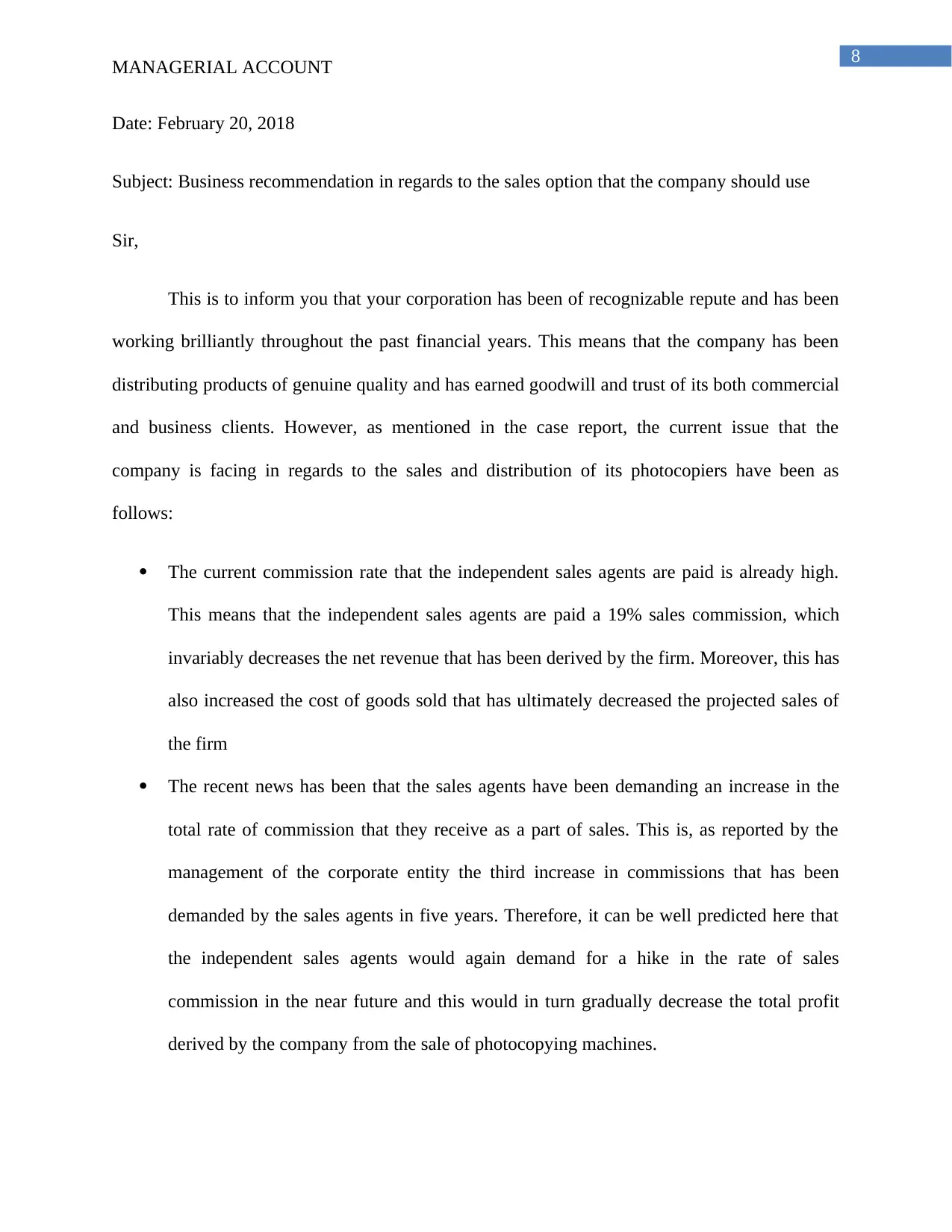
8
MANAGERIAL ACCOUNT
Date: February 20, 2018
Subject: Business recommendation in regards to the sales option that the company should use
Sir,
This is to inform you that your corporation has been of recognizable repute and has been
working brilliantly throughout the past financial years. This means that the company has been
distributing products of genuine quality and has earned goodwill and trust of its both commercial
and business clients. However, as mentioned in the case report, the current issue that the
company is facing in regards to the sales and distribution of its photocopiers have been as
follows:
The current commission rate that the independent sales agents are paid is already high.
This means that the independent sales agents are paid a 19% sales commission, which
invariably decreases the net revenue that has been derived by the firm. Moreover, this has
also increased the cost of goods sold that has ultimately decreased the projected sales of
the firm
The recent news has been that the sales agents have been demanding an increase in the
total rate of commission that they receive as a part of sales. This is, as reported by the
management of the corporate entity the third increase in commissions that has been
demanded by the sales agents in five years. Therefore, it can be well predicted here that
the independent sales agents would again demand for a hike in the rate of sales
commission in the near future and this would in turn gradually decrease the total profit
derived by the company from the sale of photocopying machines.
MANAGERIAL ACCOUNT
Date: February 20, 2018
Subject: Business recommendation in regards to the sales option that the company should use
Sir,
This is to inform you that your corporation has been of recognizable repute and has been
working brilliantly throughout the past financial years. This means that the company has been
distributing products of genuine quality and has earned goodwill and trust of its both commercial
and business clients. However, as mentioned in the case report, the current issue that the
company is facing in regards to the sales and distribution of its photocopiers have been as
follows:
The current commission rate that the independent sales agents are paid is already high.
This means that the independent sales agents are paid a 19% sales commission, which
invariably decreases the net revenue that has been derived by the firm. Moreover, this has
also increased the cost of goods sold that has ultimately decreased the projected sales of
the firm
The recent news has been that the sales agents have been demanding an increase in the
total rate of commission that they receive as a part of sales. This is, as reported by the
management of the corporate entity the third increase in commissions that has been
demanded by the sales agents in five years. Therefore, it can be well predicted here that
the independent sales agents would again demand for a hike in the rate of sales
commission in the near future and this would in turn gradually decrease the total profit
derived by the company from the sale of photocopying machines.
⊘ This is a preview!⊘
Do you want full access?
Subscribe today to unlock all pages.

Trusted by 1+ million students worldwide
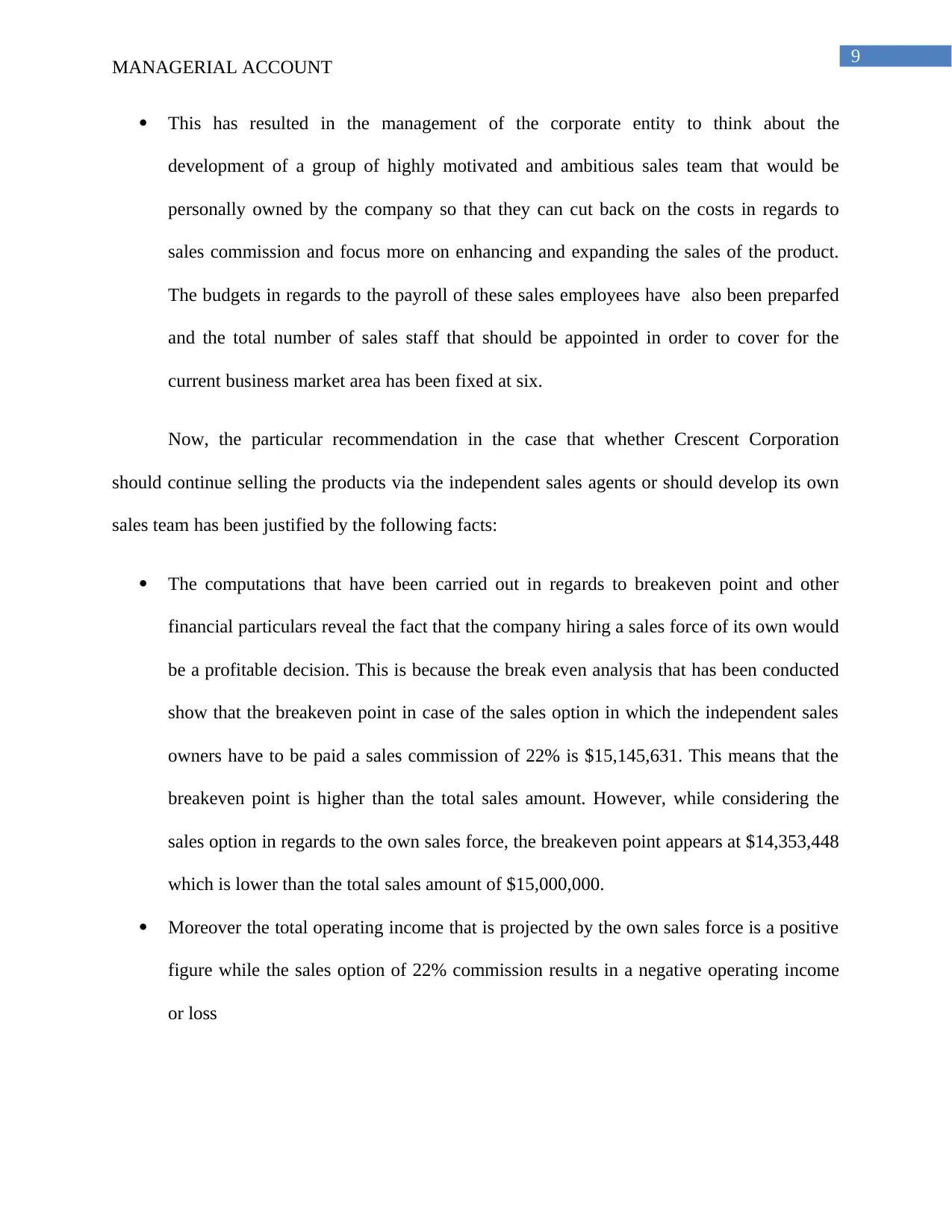
9
MANAGERIAL ACCOUNT
This has resulted in the management of the corporate entity to think about the
development of a group of highly motivated and ambitious sales team that would be
personally owned by the company so that they can cut back on the costs in regards to
sales commission and focus more on enhancing and expanding the sales of the product.
The budgets in regards to the payroll of these sales employees have also been preparfed
and the total number of sales staff that should be appointed in order to cover for the
current business market area has been fixed at six.
Now, the particular recommendation in the case that whether Crescent Corporation
should continue selling the products via the independent sales agents or should develop its own
sales team has been justified by the following facts:
The computations that have been carried out in regards to breakeven point and other
financial particulars reveal the fact that the company hiring a sales force of its own would
be a profitable decision. This is because the break even analysis that has been conducted
show that the breakeven point in case of the sales option in which the independent sales
owners have to be paid a sales commission of 22% is $15,145,631. This means that the
breakeven point is higher than the total sales amount. However, while considering the
sales option in regards to the own sales force, the breakeven point appears at $14,353,448
which is lower than the total sales amount of $15,000,000.
Moreover the total operating income that is projected by the own sales force is a positive
figure while the sales option of 22% commission results in a negative operating income
or loss
MANAGERIAL ACCOUNT
This has resulted in the management of the corporate entity to think about the
development of a group of highly motivated and ambitious sales team that would be
personally owned by the company so that they can cut back on the costs in regards to
sales commission and focus more on enhancing and expanding the sales of the product.
The budgets in regards to the payroll of these sales employees have also been preparfed
and the total number of sales staff that should be appointed in order to cover for the
current business market area has been fixed at six.
Now, the particular recommendation in the case that whether Crescent Corporation
should continue selling the products via the independent sales agents or should develop its own
sales team has been justified by the following facts:
The computations that have been carried out in regards to breakeven point and other
financial particulars reveal the fact that the company hiring a sales force of its own would
be a profitable decision. This is because the break even analysis that has been conducted
show that the breakeven point in case of the sales option in which the independent sales
owners have to be paid a sales commission of 22% is $15,145,631. This means that the
breakeven point is higher than the total sales amount. However, while considering the
sales option in regards to the own sales force, the breakeven point appears at $14,353,448
which is lower than the total sales amount of $15,000,000.
Moreover the total operating income that is projected by the own sales force is a positive
figure while the sales option of 22% commission results in a negative operating income
or loss
Paraphrase This Document
Need a fresh take? Get an instant paraphrase of this document with our AI Paraphraser
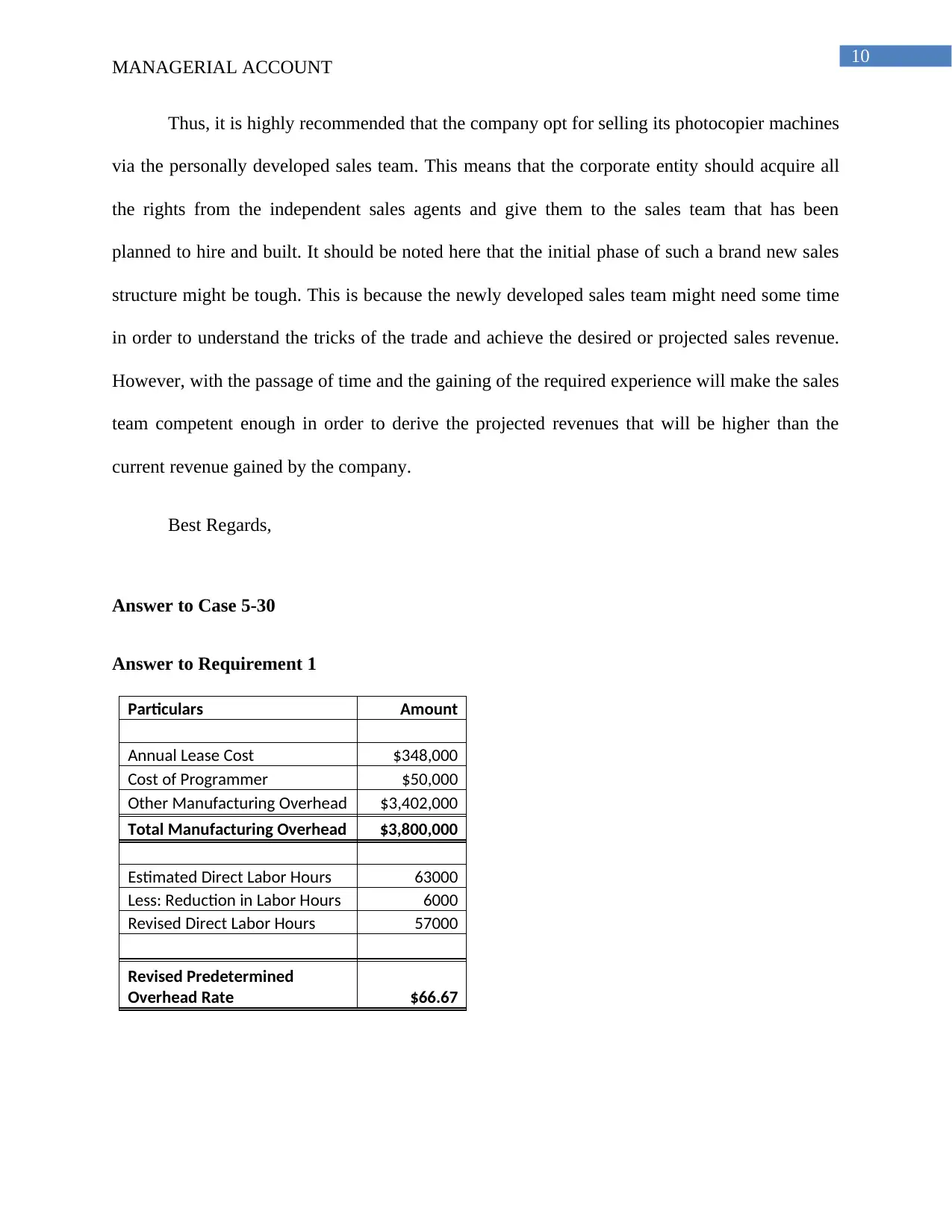
10
MANAGERIAL ACCOUNT
Thus, it is highly recommended that the company opt for selling its photocopier machines
via the personally developed sales team. This means that the corporate entity should acquire all
the rights from the independent sales agents and give them to the sales team that has been
planned to hire and built. It should be noted here that the initial phase of such a brand new sales
structure might be tough. This is because the newly developed sales team might need some time
in order to understand the tricks of the trade and achieve the desired or projected sales revenue.
However, with the passage of time and the gaining of the required experience will make the sales
team competent enough in order to derive the projected revenues that will be higher than the
current revenue gained by the company.
Best Regards,
Answer to Case 5-30
Answer to Requirement 1
Particulars Amount
Annual Lease Cost $348,000
Cost of Programmer $50,000
Other Manufacturing Overhead $3,402,000
Total Manufacturing Overhead $3,800,000
Estimated Direct Labor Hours 63000
Less: Reduction in Labor Hours 6000
Revised Direct Labor Hours 57000
Revised Predetermined
Overhead Rate $66.67
MANAGERIAL ACCOUNT
Thus, it is highly recommended that the company opt for selling its photocopier machines
via the personally developed sales team. This means that the corporate entity should acquire all
the rights from the independent sales agents and give them to the sales team that has been
planned to hire and built. It should be noted here that the initial phase of such a brand new sales
structure might be tough. This is because the newly developed sales team might need some time
in order to understand the tricks of the trade and achieve the desired or projected sales revenue.
However, with the passage of time and the gaining of the required experience will make the sales
team competent enough in order to derive the projected revenues that will be higher than the
current revenue gained by the company.
Best Regards,
Answer to Case 5-30
Answer to Requirement 1
Particulars Amount
Annual Lease Cost $348,000
Cost of Programmer $50,000
Other Manufacturing Overhead $3,402,000
Total Manufacturing Overhead $3,800,000
Estimated Direct Labor Hours 63000
Less: Reduction in Labor Hours 6000
Revised Direct Labor Hours 57000
Revised Predetermined
Overhead Rate $66.67
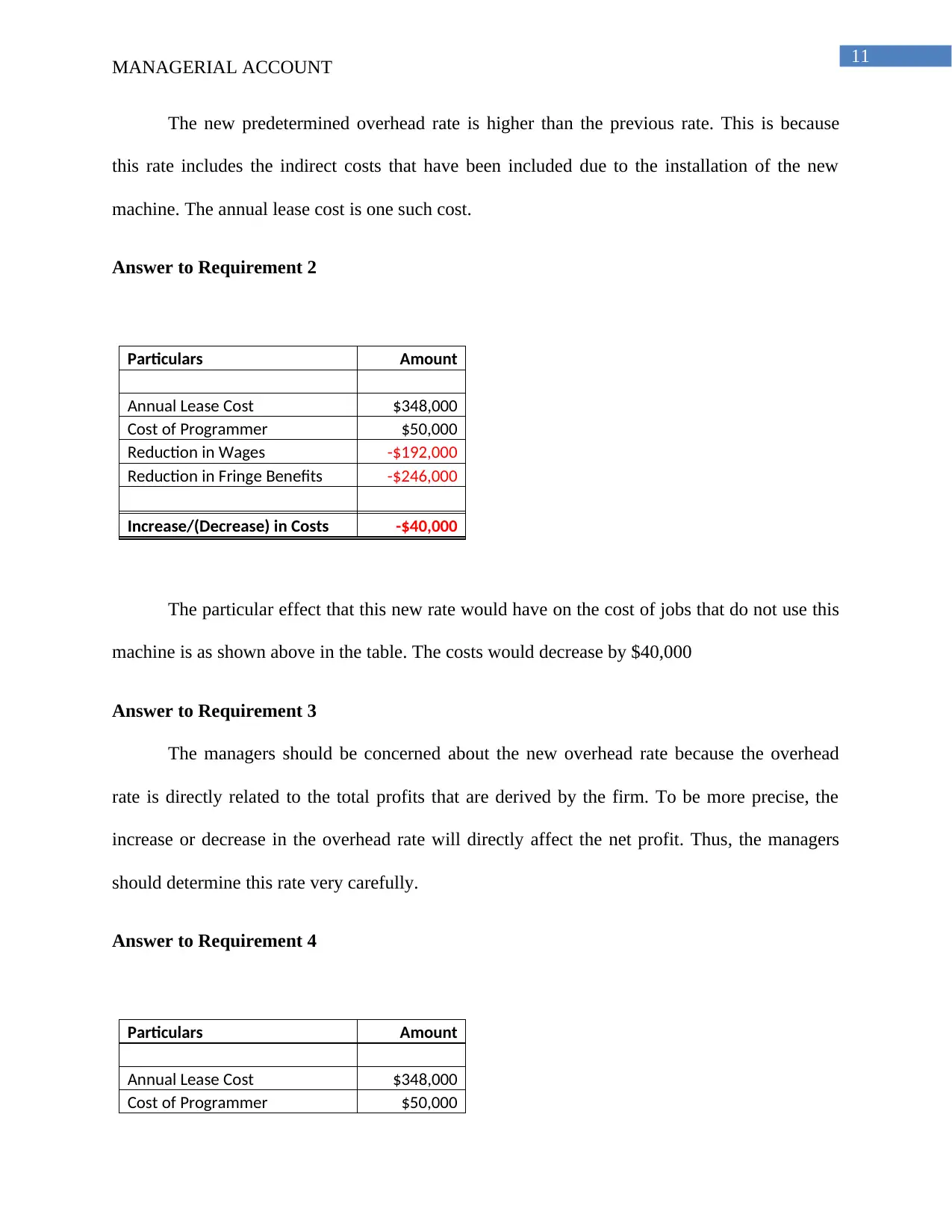
11
MANAGERIAL ACCOUNT
The new predetermined overhead rate is higher than the previous rate. This is because
this rate includes the indirect costs that have been included due to the installation of the new
machine. The annual lease cost is one such cost.
Answer to Requirement 2
Particulars Amount
Annual Lease Cost $348,000
Cost of Programmer $50,000
Reduction in Wages -$192,000
Reduction in Fringe Benefits -$246,000
Increase/(Decrease) in Costs -$40,000
The particular effect that this new rate would have on the cost of jobs that do not use this
machine is as shown above in the table. The costs would decrease by $40,000
Answer to Requirement 3
The managers should be concerned about the new overhead rate because the overhead
rate is directly related to the total profits that are derived by the firm. To be more precise, the
increase or decrease in the overhead rate will directly affect the net profit. Thus, the managers
should determine this rate very carefully.
Answer to Requirement 4
Particulars Amount
Annual Lease Cost $348,000
Cost of Programmer $50,000
MANAGERIAL ACCOUNT
The new predetermined overhead rate is higher than the previous rate. This is because
this rate includes the indirect costs that have been included due to the installation of the new
machine. The annual lease cost is one such cost.
Answer to Requirement 2
Particulars Amount
Annual Lease Cost $348,000
Cost of Programmer $50,000
Reduction in Wages -$192,000
Reduction in Fringe Benefits -$246,000
Increase/(Decrease) in Costs -$40,000
The particular effect that this new rate would have on the cost of jobs that do not use this
machine is as shown above in the table. The costs would decrease by $40,000
Answer to Requirement 3
The managers should be concerned about the new overhead rate because the overhead
rate is directly related to the total profits that are derived by the firm. To be more precise, the
increase or decrease in the overhead rate will directly affect the net profit. Thus, the managers
should determine this rate very carefully.
Answer to Requirement 4
Particulars Amount
Annual Lease Cost $348,000
Cost of Programmer $50,000
⊘ This is a preview!⊘
Do you want full access?
Subscribe today to unlock all pages.

Trusted by 1+ million students worldwide
1 out of 16
Related Documents
Your All-in-One AI-Powered Toolkit for Academic Success.
+13062052269
info@desklib.com
Available 24*7 on WhatsApp / Email
![[object Object]](/_next/static/media/star-bottom.7253800d.svg)
Unlock your academic potential
Copyright © 2020–2025 A2Z Services. All Rights Reserved. Developed and managed by ZUCOL.





